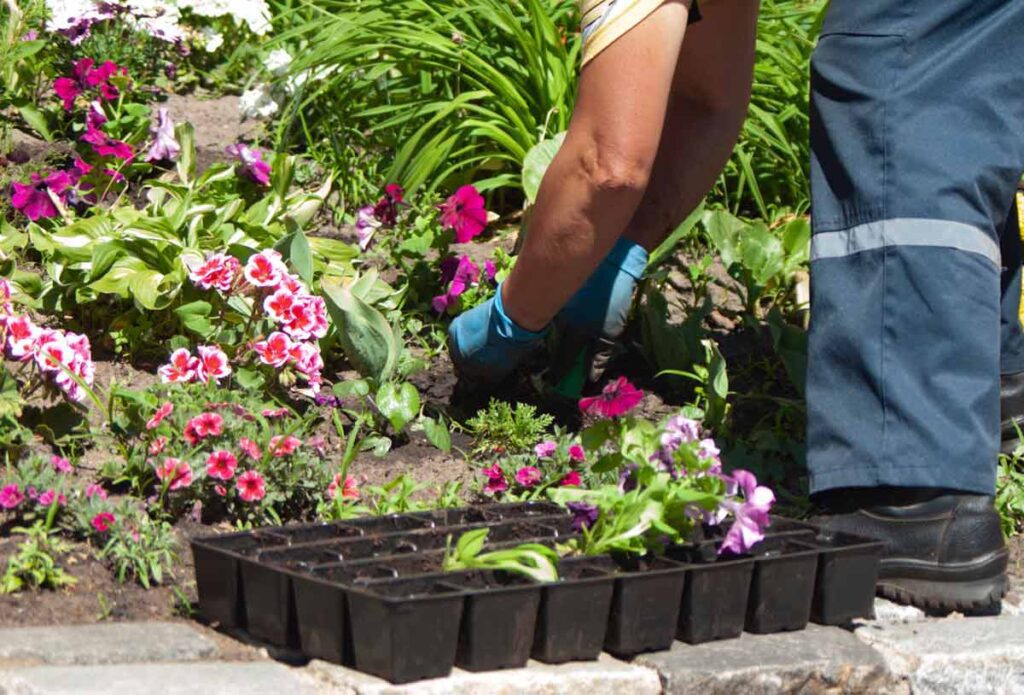
The gardening bug has bitten you, and the allure of vibrant blooms and buzzing pollinators is strong! Getting a new flower bed ready is an exciting first step, whether you’re a hands-on DIY enthusiast or considering the convenience of flower bed services from experts like us at My Neighbor Services. We will walk you through the process of preparing your garden for success, from selecting the right tools to choosing beautiful plants and offering valuable growing tips. For those seeking inspiration, exploring decorative flower bed ideas can spark creativity for your outdoor space.
Professional Flower Bed Services for Stunning Gardens
Creating captivating flower beds that enhance your home’s curb appeal often starts with expert help. Professional flower bed services can handle everything from initial soil assessment to the final planting, ensuring a seamless and successful start. If you have specific visions for custom flower bed designs, these services can bring those ideas to life. We understand the nuances of garden bed preparation and we can tailor our approach to your specific requirements and landscape design.
Preparing Your Flower Bed: A Step-by-Step Guide
1. Understanding Your Soil: The Foundation for Success
Before any digging begins, it’s wise to get your soil tested by your local Extension Service. This reveals the existing nutrient composition and the crucial pH level. Remember, most plants flourish in a neutral pH (6.5-7.0), but some have distinct preferences. For example, rhododendrons love acidic soil, while lavender prefers alkaline conditions. Incorrect pH can prevent plants from absorbing vital nutrients. Especially in urban areas, testing for lead contamination is also a cautious step for responsible lawn care.
2. Location and Sunlight: Choosing the Perfect Spot
Observe how sunlight falls across your yard throughout the day. In general, most flowering plants require 6-8 hours of direct sunlight. Shade-loving plants will thrive with 4-6 hours of direct or filtered light. An east-west facing flower bed typically provides optimal sunlight. Select a relatively flat area to avoid water pooling. Easy access to a water source will also simplify regular maintenance. Avoid planting under trees, as their roots will compete for essential resources in the top 18-24 inches of soil. If this is your first flower bed, starting with a modest size will prevent overwhelm.
3. Gathering the Right Tools:
Having the appropriate tools will make the garden bed preparation process much more efficient. Essential tools include a shovel or spade for digging, a garden fork for loosening compacted soil, a trowel or garden knife for planting and weeding, and a hoe or stirrup hoe for managing weeds.
4. Preparing the Soil: Creating a Healthy Environment
Plan the sizes of your flower bed, keeping the width to around 3-4 feet for easy access. Consider adding flower bed edging to define the space and enhance its visual appeal. Start by removing any grass and weeds, scraping away the top inch or two of soil. For larger areas, a sod cutter can be a worthwhile rental. While you can dig the removed vegetation back in, it risks spreading seeds. Herbicides are an option, but always adhere strictly to the label instructions.
Now, dig down about 12 inches, breaking up any soil clumps. For larger beds, renting a rototiller can save significant effort. After digging, enrich the soil by spreading a 2-3 inch layer of organic matter like compost, chopped leaves, or well-rotted manure and gently mixing it in. This improves soil structure, drainage, and water retention. Your soil test results will indicate any additional amendments needed.
5. The No-Dig Method: A Less Invasive Approach
For a simpler approach to garden bed preparation, consider the no-dig method. Purchase a quality planter’s mix from a landscaping company. Provide them with your flower bed dimensions (aiming for about 10-12 inches deep), and they’ll calculate the necessary amount. This is also ideal for raised beds. Simply lay down several layers of newspaper or flattened cardboard over the existing grass or weeds and then spread the planter’s mix on top. The paper will decompose, suppressing the underlying vegetation. This method also helps avoid bringing dormant weed seeds to the surface.
6. Irrigation: Ensuring Adequate Moisture
When watering, use a gentle showerhead nozzle and focus on the base of the plants. New plants need more frequent watering until they are fully established. Afterward, water deeply about once a week if there’s no rain. Remember that flowers typically require different watering than your lawn, so adjust your irrigation accordingly. Consulting with landscape services can help optimize your watering strategy.
7. Mulching: Protecting Your Investment
Applying mulch is crucial for suppressing weeds and retaining soil moisture in your new flower bed. Choose organic mulches such as shredded bark, wood chips, or compost. Avoid landscape fabric, as it can hinder planting and doesn’t effectively control weeds long-term. While gravel or stones can be used, they can reflect heat and make plant adjustments difficult.
8. What to Grow: Selecting Your Blooms
And now, the exciting part – picking your plants! Select varieties that suit your local climate, sunlight conditions, and soil type. Consider a mix of plants that bloom throughout the seasons to ensure continuous color in your outdoor space. Native plants are excellent for supporting local ecosystems and often require less maintenance. Starting with transplants from a garden center is often advised. Follow package instructions for initial fertilization. Established perennials and bulbs typically need minimal feeding, usually a granular application in early spring.
Examples of Flowers:
- Spring: Daffodils, tulips, columbine, woodland sedum, pansies, violas, snapdragons
- Summer: Lilies, coneflowers, black-eyed Susan, garden phlox, cosmos, flowering tobacco
- Fall: Saffron, colchicum, asters, mums, pansies, ornamental cabbage, kale
Enhancing Your Landscape Design and Curb Appeal
Well-maintained flower beds are a cornerstone of attractive landscape design and significantly boost your home’s curb appeal. Integrating your flower beds with your existing lawn care routine and other elements of your outdoor space creates a cohesive and inviting look. Regular maintenance is needed in keeping your flower beds vibrant and healthy.
Frequently Asked Questions About Flower Bed Services
How can flower bed services enhance my curb appeal?
Professionals can design and install visually appealing flower beds tailored to your home’s style and the surrounding landscape, instantly boosting its attractiveness.
What are some popular decorative flower bed ideas?
Options range from formal, symmetrical designs to more naturalistic, cottage-style plantings. Consider incorporating varying heights, textures, and colors for visual interest.
Can custom flower bed designs address specific needs, like attracting pollinators?
Absolutely! Designers can select plant combinations known to attract bees, butterflies, and other beneficial insects.
What does regular maintenance for flower beds typically involve?
This includes regular weeding, deadheading spent blooms, watering, and seasonal fertilization.
Final Thoughts
Preparing your flower bed is the first step towards a beautiful and thriving garden. Whether you tackle it yourself or enlist the help of flower bed services, the effort you put in now will pay off with a season of colorful blooms and enhanced enjoyment of your outdoor space. Remember to think about your local climate, soil conditions, and personal preferences to create a garden that truly reflects your style and supports a vibrant ecosystem. If you need help, My Neighbor Services offers flower bed services, flower bed edging, and many more. Call us today for a free consultation.
